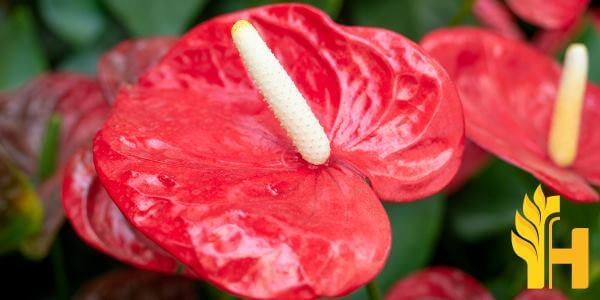Anthurium price

Where to buy and sell Anthurium, lowest (cheapest) and highest price.
check offers buy sell AnthuriumToday price for AnthuriumAnthurium wholesale prices 2022
The Current commodity price of Anthurium per kg, pound in the world in the global markets
anthurium
Price range: 20 - 30 INR / 100 kg | Market: Flower Market,Gazipur Market | Date: 2024-05-29
anthurium flower orange green edge
Price range: 11 - 11 CNY / 1 kg | Market: Taipei Market | Date: 2024-05-06
anthurium flower red and green edge
Price range: 7 - 7 CNY / 1 kg | Market: Taipei Market | Date: 2024-05-06
anthurium flower red and green heart
Price range: 6 - 8 CNY / 1 kg | Market: Taipei Market | Date: 2024-05-06
Anthurium
Anthurium - one of the most-bought potted plants. The original, exotic appearance makes this flower attractive as a gift. It owes its unusual form mainly to its interesting structure. There is a slightly bent or straight, uniform butt, tapering towards the apex, surrounded by a heart-shaped, decorative scabbard in white, green, yellow, pink, red, burgundy, or purple colors mounted on a long shoot. There are inconspicuous flowers placed close to each other on the flask.Although in our flower shops we most often find plants with an upright habit, anthurium can also have a climbing or hanging form. Shiny and dark green leaves are undoubtedly an ornament of the plant, used by florists to create compositions and bouquets. Anthurium is also sold as a cut flower, as it can stay fresh for up to several weeks when placed in a vase filled with water.
This pictorial species is native to neotropical landscapes stretching from Argentina to northern Mexico. It is found in mountain forests and humid equatorial forests. The greatest variety of anthurium cultivars was registered in Costa Rica and Panama, which additionally have the highest number of endemic species of this plant.
Although the juice of this plant may cause severe swelling or a skin rash, the roots of this plant were used by the Mayans as a laxative.
Due to its exotic origin and high requirements, caring for anthurium at home is not the easiest thing to do. The flower requires a humus-rich, light, permeable substrate necessarily with a layer of drainage, high air humidity, and heat. The position is also important. The plant likes bright places, but with diffused light. Leaves can easily be burned in direct sunlight. The plant is also sensitive to the temperature of the ground. Placed on a cold marble windowsill in a ceramic pot, it can grow poorly. Large and stately flowers should be supported and protected against breaking. During the growth period, anthurium requires regular watering with stagnant water at ambient temperature, in winter watering should be limited.
Anthurium is mostly exported to Europe, Japan, and the United States. The largest producers of this flower are the Netherlands and the island of Mauritius. Paired with orchids, anthurium makes up to 90% of total tropical flowers exported to the United States. The total amount of money provided from the anthurium trade is established as $34 million euro annually.
Global anthurium production
In 2013, anthurium production totaled 5,700 metric tons, worth $27.1 million USD. The majority of anthurium production takes place in Hawaii, which produced 4,200 metric tons in 2013 valued at $20.1 million. Other significant producers include Colombia (800 metric tons), Costa Rica (600 metric tons), and Ecuador (100 metric tons). The great majority of anthurium species are native to Colombia. Ecuador is home to about 200 species, while Peru and Panama each have around 100 species. The Caribbean islands combined have less than 50 anthurium species. Puerto Rico has the greatest diversity of anthurium species in the Caribbean, with 22 species. Anthurium cultivation first began in Hawaii in the late 19th century. Hawaii remains the largest producer of anthuriums, with about 90% of all commercially grown anthuriums coming from the islands. Anthurium production in Hawaii has declined in recent years, due to competition from South American producers. Colombia is the second-largest producer of anthuriums, with 800 metric tons produced in 2013. The majority of Colombia's anthurium production takes place in the department of Antioquia, specifically in the municipality of Santa Bárbara. Costa Rica is the third-largest producer of anthuriums, with 600 metric tons produced in 2013. The vast majority of Costa Rica's anthurium production takes place in the province of Alajuela. Ecuador is the fourth-largest producer of anthuriums, with 100 metric tons produced in 2013. The majority of Ecuador's anthurium production takes place in the provinces of Cotopaxi and Pichincha. Puerto Rico is the fifth-largest producer of anthuriums, with 50 metric tons produced in 2013. Puerto Rico has the greatest diversity of anthurium species in the Caribbean, with 22 species.Download our new
Husfarm App
Stay up to date with the current prieces of agricultural products all over the world.
Do you want to sell agricultural products?
Are you an Agricultural processor looking for high-quality products to buy?
Post an ad for FREE!
